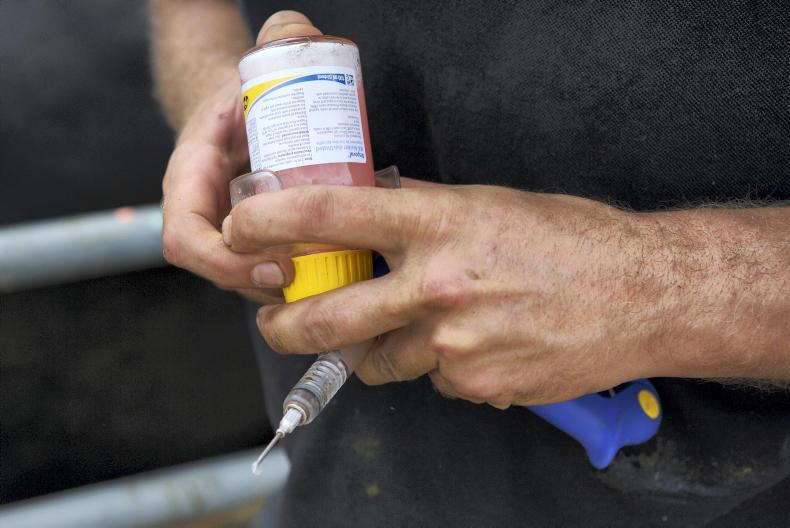The glaring one for sucklers post-calving is magnesium. Cows are poor at storing magnesium and so it must be supplied daily. Failure to do so risks grass tetany. Stressors increase the risk. These include the suckling calf, unsettled weather, low feed supply or high potassium (K) intake via pastures that received lots of K fertiliser or high potassium silage (Irish silage is typically high in potassium).
A freshly calved cow standing in a bare, mucky paddock with a ring feeder full of silage, cold wet weather overhead and a calf pulling out of her is a prime tetany candidate. This would have been a common scenario across the country in recent weeks. She needs to consume 30g of supplemented magnesium daily – the equivalent of 60g of calmag. For me, as you’re turning out cows and calves a magnesium nut is a no-brainer. It will facilitate herding, get much-needed magnesium in and help keep energy levels up before cows can get down the farm into proper grass covers.
Once down the farm, where concentrates may not be an option, look to lick buckets, flakes or tablets in water or pasture dusting as means to supplement magnesium. Exercise caution with lick buckets as not all cows visit them daily.
As the breeding season approaches, other compounds need our attention as well as magnesium, namely the fertility minerals: copper, selenium, iodine, zinc, manganese, cobalt. Vitamin E and sodium should be supplemented too.
Table 1 outlines the daily requirements for these, as well as magnesium, and though most bucket and bolus products will contain all of the required compounds, check your labels to be sure.
Vaccinations
Leptospirosis and BVD can hit a suckler herd hard. Vaccinations against these are ideally timed in the coming weeks, prior to breeding. Depending on the products, animals can be vaccinated against both diseases on the same day around four weeks before they’re due to be served. The first time an animal receives these vaccinations, two shots around a month apart are usually required, ideally both before the start of breeding. As with all vaccinations, consult your vet regarding best practice. While cattle are in, this would also be a good time to vaccinate calves against clostridial disease – likely a two-course treatment. Also, carry out a pre-breeding scan to help minimise the incidence of slipping or empty cows and take a weight on calves.
Many herds will also vaccinate or give boosters for IBR prior to breeding. For me, IBR vaccination is a no-brainer for any herds buying stock in. Take note that where a live vaccine is used there must be an all-or-nothing policy – every animal in the herd should receive the vaccine. If not, unvaccinated animals can develop clinical IBR from exposure with vaccinated animals in times of stress.
Read more
Special focus: animal health 2017
The glaring one for sucklers post-calving is magnesium. Cows are poor at storing magnesium and so it must be supplied daily. Failure to do so risks grass tetany. Stressors increase the risk. These include the suckling calf, unsettled weather, low feed supply or high potassium (K) intake via pastures that received lots of K fertiliser or high potassium silage (Irish silage is typically high in potassium).
A freshly calved cow standing in a bare, mucky paddock with a ring feeder full of silage, cold wet weather overhead and a calf pulling out of her is a prime tetany candidate. This would have been a common scenario across the country in recent weeks. She needs to consume 30g of supplemented magnesium daily – the equivalent of 60g of calmag. For me, as you’re turning out cows and calves a magnesium nut is a no-brainer. It will facilitate herding, get much-needed magnesium in and help keep energy levels up before cows can get down the farm into proper grass covers.
Once down the farm, where concentrates may not be an option, look to lick buckets, flakes or tablets in water or pasture dusting as means to supplement magnesium. Exercise caution with lick buckets as not all cows visit them daily.
As the breeding season approaches, other compounds need our attention as well as magnesium, namely the fertility minerals: copper, selenium, iodine, zinc, manganese, cobalt. Vitamin E and sodium should be supplemented too.
Table 1 outlines the daily requirements for these, as well as magnesium, and though most bucket and bolus products will contain all of the required compounds, check your labels to be sure.
Vaccinations
Leptospirosis and BVD can hit a suckler herd hard. Vaccinations against these are ideally timed in the coming weeks, prior to breeding. Depending on the products, animals can be vaccinated against both diseases on the same day around four weeks before they’re due to be served. The first time an animal receives these vaccinations, two shots around a month apart are usually required, ideally both before the start of breeding. As with all vaccinations, consult your vet regarding best practice. While cattle are in, this would also be a good time to vaccinate calves against clostridial disease – likely a two-course treatment. Also, carry out a pre-breeding scan to help minimise the incidence of slipping or empty cows and take a weight on calves.
Many herds will also vaccinate or give boosters for IBR prior to breeding. For me, IBR vaccination is a no-brainer for any herds buying stock in. Take note that where a live vaccine is used there must be an all-or-nothing policy – every animal in the herd should receive the vaccine. If not, unvaccinated animals can develop clinical IBR from exposure with vaccinated animals in times of stress.
Read more
Special focus: animal health 2017






 This is a subscriber-only article
This is a subscriber-only article










SHARING OPTIONS: